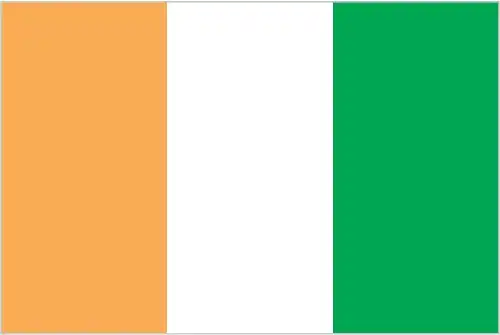Côte d'Ivoire Flag
National Flag of Côte d'Ivoire
Côte d'Ivoire Flag Display

Quick Facts About Côte d'Ivoire and Côte d'Ivoire Flag
- Adopted:
- Aspect Ratio:
- 2:3
- Capital:
- Yamoussoukro
- Population:
- 27.5 million
Flag Description
The flag of Côte d'Ivoire features three vertical bands of orange, white, and green. The orange represents the savannas of the north and the fertility of the land, the white symbolizes peace and unity, and the green represents the forests of the south and hope for the future. The colors are inspired by the Pan-African movement and represent the country's natural resources and aspirations.
Symbolism & Meaning of the Côte d'Ivoire Flag
Orange for northern savannas and land fertility, white for peace and unity, green for southern forests and hope.
Historical Background of the Côte d'Ivoire Flag
Adopted in 1959, the flag was designed to represent the country's natural diversity and its commitment to peace and unity. The design was inspired by the French tricolor and the Pan-African colors, reflecting Côte d'Ivoire's colonial heritage and African identity.
Design Elements of the Côte d'Ivoire Flag
Three vertical bands (orange-white-green).
Usage & Protocol of the Côte d'Ivoire Flag
Flown on government buildings and during national celebrations. The flag represents the country's natural wealth and commitment to peace. Displayed during official ceremonies and international events. Must be properly maintained and treated with respect.
Frequently Asked Questions
What do the colors of the Côte d'Ivoire Flag represent?
Orange for northern savannas and land fertility, white for peace and unity, green for southern forests and hope.
When was the Côte d'Ivoire Flag adopted?
The Côte d'Ivoire flag was adopted on 1959, marking an important milestone in the country's development as an independent nation.
What is the aspect ratio of the Côte d'Ivoire Flag?
The Côte d'Ivoire flag has an aspect ratio of 2:3, which determines the proportional relationship between its width and height for official display purposes.